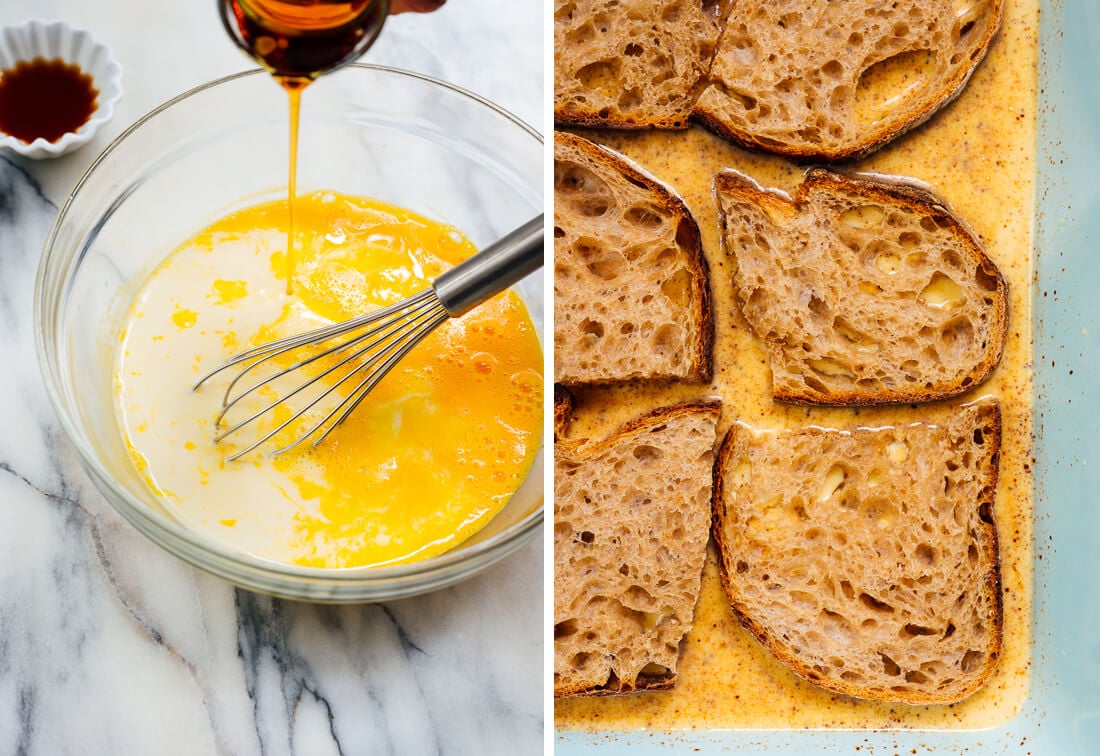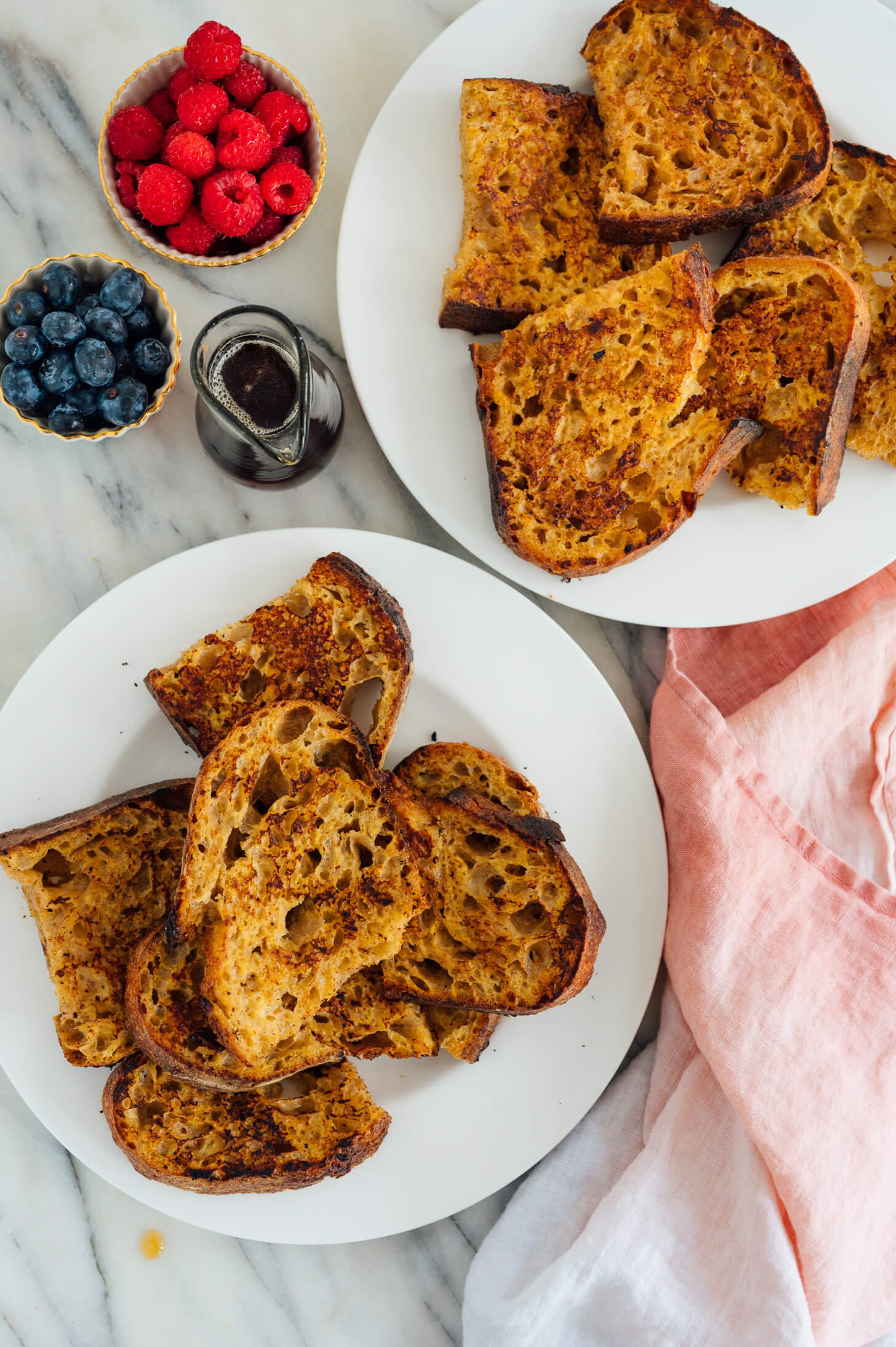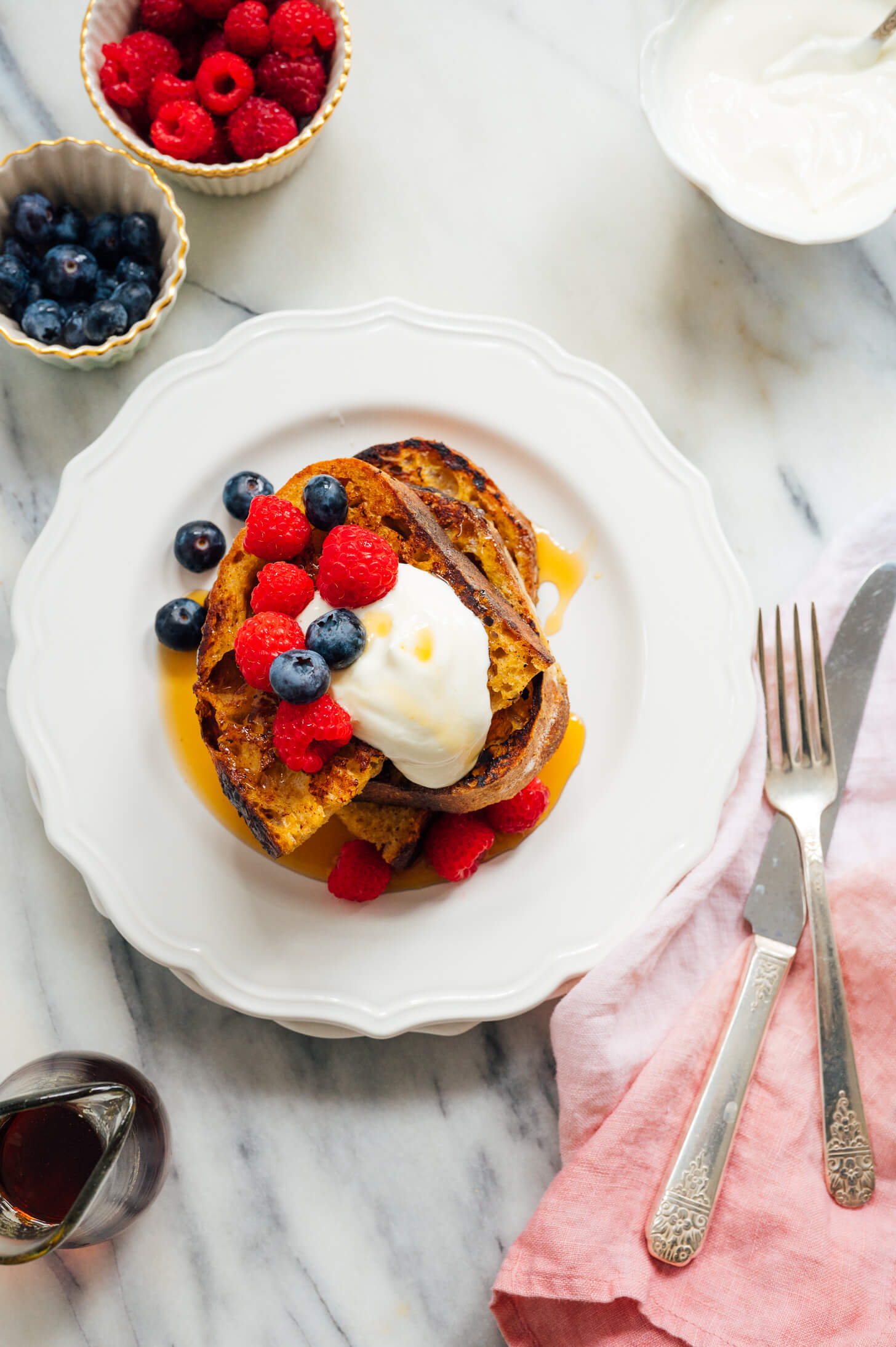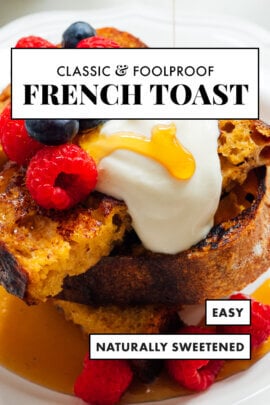Foolproof French Toast

Let’s hear it for French toast! The best French toast is seared golden on the outside, tender in the middle, lightly sweet and deliciously custard-y. This French toast recipe meets all of those qualifications with flying colors.
This recipe bypasses all of the common French toast downfalls. Perhaps your previous attempts have yielded soggy, falling apart, eggy toast—never again! I’ve studied French toast techniques and this recipe will not let you down.

French toast, known as pain perdu in France, is one of many brilliant uses for stale bread. It’s true that French toast turns out best when made with stale bread. However, you can absolutely make French toast if your bread is still fresh. The trick is to quickly dehydrate sliced bread in the oven so your French bread doesn’t turn out too soggy—I’ll walk you through this step below.
This French toast is perfect for a special brunch at home. Make some for Mom tomorrow? (Here are more Mother’s Day recipes.) The recipe is simple enough to make on a regular weekend as well. Let’s make some!

French Toast Ingredients
Bread
So many options here! My favorite bread for French toast is a fluffy locally made whole grain sourdough. Challah or brioche will yield extra indulgent, fancy restaurant-style French toast. Sandwich bread works as well—ideally thick cut, but regular slices will be fine.
Milk
Whole milk is ideal here because it yields rich results. Two percent milk will work as well. Or try a thick non-dairy milk, like homemade cashew milk or Forager’s brand cashew milk.
Egg Yolks
That’s right, we’re using the yolks only. Egg whites are responsible for the sulfurous, “eggy” flavor that sometimes overpowers French toast. I learned this tip from America’s Test Kitchen, and it’s true!
Uses for leftover egg whites: You’ll have three leftover egg whites, which you can turn into a single-serving egg white scramble, or add five more eggs to make four servings of scrambled eggs.
Butter
We’ll mix melted butter directly into the custard. This way, the butter permeates the bread for extra richness and nutty, seared butter flavor. We do not need to butter the skillet while we’re cooking the French toast, as butter tends to burn against the skillet. There’s plenty within the batter, even if you’re cooking on stainless steel or cast iron.
Maple Syrup
Real maple syrup naturally sweetens our batter. You can also use brown sugar. Two tablespoons of sweetener yields lightly sweet French toast. Serve your toast with additional maple syrup so everyone can make their French toast as sweet as they’d like.
Vanilla Extract
One whole tablespoon of vanilla extract really makes this French toast taste like a treat. Don’t worry, it’s not too much.
Cinnamon & Salt
Ground cinnamon is the perfect complement to the vanilla custard, and salt amplifies all of the other flavors.

How to Make French Toast
You’ll find the full recipe below. Here are three key tips before you get started:
1) Stale bread is key.
If your bread is soft and fresh, it will be difficult to work with and will produce soggy French toast. We don’t want that! You can easily dehydrate sliced bread at a low oven temperature (300 degrees Fahrenheit) in under 15 minutes. See step one for details.
2) Soak to a depth of 1/4-inch.
Simply dunking your bread in custard will yield dry, spotty results, and soaking the bread too long will yield soggy, floppy slices. Stale bread needs a minute or three to absorb some of the mixture. Pour the custard into a 9 by 13-inch baking dish and you can float multiple slices at once.
The key is to let the slices rest until the custard has soaked in to a depth of about 1/4-inch, then flip and repeat for the other side. Ideally, you want a thin layer of unsoaked bread in the middle, which helps retain the bread’s structure.
3) Work in batches.
French toast really isn’t fussy to make if you have a system in place, and it’s even easier if you have a kitchen helper. Soak a batch of bread as described above, then transfer the soaked bread to a rimmed baking sheet while you preheat the skillet or griddle.
Cook up your first batch, then start soaking the next batch. Or, if you have a helper, they can work on soaking the next batch while you’re cooking.

French Toast Serving Suggestions
Toppings
Always serve with additional maple syrup. Add any of these optional toppings:
- Fresh berries, like raspberries, blueberries, blackberries or sliced strawberries
- Berry compote
- Sliced ripe bananas
- Pats of butter
- Whipped cream or Greek yogurt
- Dollop of nut butter, like almond butter or pecan butter or peanut butter
- Sprinkle of powdered sugar
Accompaniments
French toast is lovely with:
- Mimosas
- Bellinis, when peaches are in season
- Frittatas, breakfast casserole or scrambled eggs for additional protein

More Sweet Breakfast Treats
These wholesome breakfast recipes taste like a treat:
Please let me know how your French toast turns out in the comments! I love hearing from you.

Foolproof French Toast
- Author:
- Prep Time: 15 minutes
- Cook Time: 20 minutes
- Total Time: 35 minutes
- Yield: 8 to 12 slices 1x
- Category: Breakfast
- Method: Stovetop
- Cuisine: French
- Diet: Vegetarian
Learn how to make the best French toast at home! This foolproof recipe yields French toast that’s fluffy, tender, lightly sweet and golden brown. This recipe yields 8 large or 12 medium slices of French toast (4 servings).
Ingredients
- 1 medium loaf of bread* (about 16 ounces, see step 1)
- 1 ½ cups whole milk**
- 3 egg yolks
- 2 tablespoons unsalted butter, melted
- 2 tablespoons maple syrup or brown sugar
- 1 tablespoon vanilla extract
- 1 teaspoon ground cinnamon
- ¼ teaspoon fine salt
- For serving: Maple syrup, butter, fresh berries or berry compote, whipped cream or Greek yogurt, sprinkle of powdered sugar…
Instructions
- Cut your bread into ¾-inch thick slices, to yield about 8 large or 12 medium slices of bread. If your bread is stale, move onto the next step. If your bread is fresh and soft, preheat the oven to 300 degrees Fahrenheit. Place the sliced bread onto a large, rimmed baking sheet lined with an oven-safe cooling rack (if you have one) and bake for 8 minutes. If the bread still feels soft and squishy on the bottom sides, flip them and bake for an additional 4 to 8 minutes. We’re aiming for “stale bread” texture, not crispy toast. Set aside to cool.
- Gently warm the milk in the microwave or in a saucepan on the stovetop, just until it’s warmer than room temperature (otherwise, the melted butter will clump on impact). Set aside.
- Separate the yolks from three eggs, reserving the whites for another use if desired. In a medium mixing bowl, whisk the egg yolks until well blended. Add the warmed milk, melted butter, maple syrup, vanilla, cinnamon and salt, and whisk until blended. Pour the mixture into a 9 by 13-inch baking dish.
- If you’re using an electric skillet, preheat it to 350 degrees Fahrenheit now. Place the sliced bread in the egg mixture, working with one side at a time. Once the bottom sides have absorbed egg mixture to a depth of about ¼-inch, flip each slice and repeat for the other side. Transfer the soaked slices to your prepared baking sheet.
- Whisk the egg mixture once again to redistribute the cinnamon. Repeat with the remaining slices, whisking the mixture between batches.
- If you are not using an electric skillet, heat a skillet (ideally cast iron) or griddle over medium-low heat. You’re ready to start cooking the bread once a drop of water sizzles on contact with the hot surface. Note that we will not be using any butter or cooking spray to cook the toast—there’s enough butter in the batter already.
- Once your cooking surface is sufficiently preheated, start cooking! Gently transfer a slice(s) to the skillet and cook until the underside is nicely golden, about 3 to 4 minutes. Flip and repeat with the other side, then transfer the toast to a clean cooling rack or serving platter. As time goes on, dial the heat down if your toast becomes too golden on the outside before the inside cooks through. Repeat with remaining French toast (if you have extra bread and batter left, you could cook a few extra slices).
- Serve French toast on plates with desired garnishes. Enjoy!
Notes
Recipe adapted from America’s Test Kitchen and Cook’s Illustrated.
*Bread suggestions: I love to use fluffy whole grain sourdough, which offers some light nutty flavor. Challah, brioche or a wide loaf of French bread or even sandwich bread (ideally thick cut) will all work well.
**Milk options: Whole milk is ideal. You could use 2 percent milk for less rich results. Or try a thick non-dairy milk, like homemade cashew milk or Forager’s brand cashew milk.
Make it dairy free: Use a thick non-dairy milk, like homemade cashew milk or Forager’s brand cashew milk. Though I haven’t tried, I believe you could successfully replace the butter with melted coconut oil or vegan butter.




This is the fitting weblog for anyone who desires to seek out out about this topic. You understand so much its nearly arduous to argue with you (not that I truly would need…HaHa). You positively put a new spin on a topic thats been written about for years. Nice stuff, simply nice!